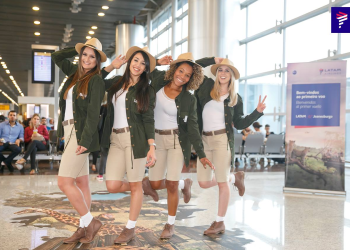Introduction
Air travel with infants and toddlers can be a daunting prospect for parents, but with careful planning and preparation, it’s possible to ensure a smooth and stress-free journey for the whole family. In this article, we’ll share a variety of tips and strategies to help parents navigate air travel with young children, from booking flights and packing essentials to managing in-flight challenges and interacting with fellow passengers.
Planning Ahead
Before embarking on your journey, take the time to plan ahead and make arrangements to streamline the travel process. Book flights during optimal times to coincide with your child’s sleep schedule, and consider selecting seats near the front of the aircraft for easy access to bathrooms and other amenities. Additionally, notify the airline in advance if you require special accommodations, such as a bassinet or child-friendly meal options.
Packing Essentials
When packing for air travel with infants and toddlers, it’s essential to pack strategically to ensure you have everything you need for a comfortable journey. Be sure to include plenty of diapers, wipes, and changing supplies, as well as extra clothing and comfort items such as blankets and pacifiers. Consider packing a separate diaper bag with essentials for easy access during the flight.
Navigating the Airport
Arrive at the airport early to allow plenty of time to check in, go through security, and navigate to your gate. Take advantage of family lanes and priority boarding options to expedite the process, and be prepared to manage security screenings with children, including removing shoes, jackets, and electronics from carry-on bags.
Entertainment and Distractions
Keeping infants and toddlers entertained during flights can help make the journey more enjoyable for everyone. Pack a variety of toys, books, and electronic devices to keep children engaged, and consider bringing along snacks and games to help pass the time. Be mindful of noise levels and respectful of fellow passengers, especially during periods of rest or relaxation.
Feeding and Hydration
Maintaining proper hydration and nutrition is essential for infants and toddlers during air travel. If breastfeeding, consider nursing or offering a bottle during takeoff and landing to help equalize ear pressure. For older children, pack plenty of snacks and drinks to keep them nourished and hydrated throughout the flight.
Managing Sleep and Comfort
Creating a comfortable sleep environment can help infants and toddlers rest more easily during flights. Pack familiar comfort items such as blankets and stuffed animals, and consider using travel-friendly sleep aids such as white noise machines or portable crib attachments. Encourage children to nap or rest during the flight to minimize disruptions and promote a more relaxed travel experience.
Dealing with Ear Pressure
Changes in air pressure during takeoff and landing can cause discomfort for infants and toddlers, leading to fussiness or crying. Encourage swallowing by offering a pacifier, bottle, or breastfeeding during these times to help equalize ear pressure and alleviate discomfort. Additionally, consider using earplugs or noise-canceling headphones to minimize noise distractions during the flight.
Navigating In-Flight Challenges
Handling diaper changes, bathroom breaks, and unexpected tantrums or meltdowns during flights requires patience and flexibility. Be prepared to address these challenges calmly and efficiently, and consider bringing along a change of clothes and extra supplies in case of spills or accidents. Communicate openly with flight attendants if you require assistance or support during the flight.
Interacting with Fellow Passengers
Maintaining positive interactions with fellow passengers can help ensure a pleasant travel experience for everyone on board. Communicate openly and respectfully with nearby passengers, especially if your child’s behavior may impact their experience. Be prepared to handle unexpected reactions or comments with grace and understanding, and prioritize the well-being of your child while respecting the needs of others.
Utilizing Airline Resources
Take advantage of the resources and amenities offered by the airline to help make your journey more comfortable and convenient. Seek assistance from flight attendants if you require additional supplies or support during the flight, and explore family-friendly amenities such as children’s entertainment programs or special meal options. Remember that airline staff are there to help ensure a safe and enjoyable travel experience for all passengers.
Post-Flight Strategies
Upon arrival at your destination, take some time to settle in and adjust to your new surroundings. Help your child acclimate to any time zone changes or jet lag by maintaining a consistent sleep schedule and exposing them to natural light during the day. Reflect on your travel experience and consider any lessons learned or adjustments to make for future trips with infants and toddlers.
Preparing for Return Flights
As your journey comes to a close, take proactive steps to prepare for your return flight home. Reassess your packing and supplies to ensure you have everything you need for the journey, and consider any adjustments based on your experiences during the outbound flight. Take time to rest and recharge before your return journey to ensure you’re ready for the challenges and adventures that lie ahead.
Conclusion
Air travel with infants and toddlers presents unique challenges for parents, but with careful planning and preparation, it’s possible to ensure a smooth and enjoyable journey for the whole family. By following the tips and strategies outlined in this article, parents can navigate air travel with confidence, knowing they have the tools and resources to handle any situation that may arise. With patience, flexibility, and a positive attitude, air travel with young children can be a rewarding and memorable experience for everyone involved.

FAQs After The Conclusion
1. Can I bring a car seat or stroller on the plane?
- Most airlines allow parents to bring a car seat or stroller on the plane free of charge, either as checked baggage or as carry-on items. Be sure to check with your airline for specific policies and guidelines.
2. Are there any restrictions on bringing baby food or formula through security?
- TSA regulations allow parents to bring reasonable quantities of baby food, formula, and breast milk through security checkpoints, even if they exceed the usual 3.4-ounce limit for liquids and gels. Be prepared to declare these items and undergo additional screening if necessary.
3. How can I help my child adjust to jet lag after a long flight?
- To help your child adjust to jet lag, maintain a consistent sleep schedule, expose them to natural light during the day, and avoid excessive napping. Encourage physical activity and outdoor play to help regulate their sleep-wake cycle and promote restful sleep at night.
4. What should I do if my child becomes ill during the flight?
- If your child becomes ill during the flight, notify a flight attendant immediately for assistance. They can provide basic first aid supplies and may be able to arrange for medical assistance upon landing if necessary. Be sure to pack any essential medications or medical supplies in your carry-on bag for easy access during the flight.
5. How can I keep my child entertained during long flights?
- Pack a variety of toys, books, and electronic devices to keep your child entertained during long flights. Consider bringing along portable games, coloring books, and favorite snacks to help pass the time. Additionally, encourage your child to explore the in-flight entertainment options provided by the airline.
6. Are there any specific safety precautions I should take when traveling with infants and toddlers?
- When traveling with infants and toddlers, it’s essential to prioritize safety at all times. Ensure that your child is properly secured in a car seat or restraint during taxi, takeoff, and landing, and supervise them closely in crowded or unfamiliar environments. Be vigilant about potential hazards such as sharp objects, hot surfaces, and choking hazards, and take proactive steps to mitigate risks whenever possible.
7. What should I do if my child experiences motion sickness during the flight?
- If your child experiences motion sickness during the flight, try to minimize discomfort by keeping them hydrated and encouraging them to focus on a fixed point outside the aircraft. Consider packing motion sickness remedies such as ginger candies or acupressure wristbands, and notify a flight attendant for assistance if necessary. Be prepared to clean up any messes promptly and discreetly to avoid inconveniencing other passengers.
8. How can I help my child feel more comfortable and relaxed during air travel?
- To help your child feel more comfortable and relaxed during air travel, create a familiar and soothing environment by bringing along favorite comfort items such as blankets, stuffed animals, and pacifiers. Encourage relaxation techniques such as deep breathing or gentle massage, and provide plenty of reassurance and support throughout the journey. By fostering a sense of security and calmness, you can help your child feel more at ease during air travel and reduce the likelihood of stress or anxiety.







